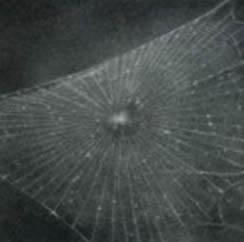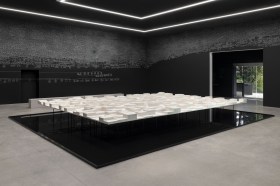Charles Jencks’s Landform has transformed the approach to this gallery since 2002, which means that I haven’t been for over seven years, an alarming thought. I consider the sculptured ground modelling to be a significant improvement on the empty lawn that preceded it, but I wouldn’t like to be the groundsman who has to mow these banks and maintain the precision of the piece. I was visiting with an architect friend who says that already the sharp edges have been smoothed up thanks to time and trampling. A sign asks “Please don’t use the top path”, so we dutifully avoided the crest of the ridge while others flagrantly disregarded the polite request. Landform is a major work but one which ultimately falls short of being satisfactory. Despite the sign there are no paths, only grassed banks and ramps, so this interactive sculpture is only good until it gets worn out. Jencks is not a Landscape Architect or he would know that that was a fault in his design. Never mind, it is a bit of bold artistic thinking which makes a good contribution.
Currently the gallery is staging an exhibition entitled Artist Rooms, with six featured artists. Over 700 works recently acquired jointly by the National Galleries of Scotland and the Tate make up the resource for the exhibition, which is touring throughout the year. The brochure declares ‘At the heart of Artist Rooms is the concept of individual rooms devoted to particular artists…’ So, it’s probably best not to bother with the brochure. Just dive in.
One room has a series of Warhol photographs which are grouped and stitched together in fours. It’s about repetition and it holds the interest for a nano-second, which is a shame because this artist was shown in a much better light a couple of years ago at the Royal Scottish Academy. Part of the rationale for Artist Rooms is to allow the works to be seen and appreciated in depth, but to fill a room with only these stitched images doesn’t even invite an in-depth study. As I said, ditch the brochure – and perhaps sack the copy writer.
Damien Hirst is given almost half of the ground floor to himself. The corridors have his poster series and the rooms display his various fascinations with chemist shops and museums. Through them all, the one constant with Hirst is precision. One has to admire the quality with which every work is manufactured and presented even if, like so many visitors, you end up saying “So what.” Hirst is seen here as a classic Pop artist in the Warhol tradition. Take an everyday item, enlarge and frame it, then display out of context. He’s holding up a mirror to life but doesn’t move things along from Brillo boxes or soup cans.
Vija Celmins, Ellen Gallagher, Alex Katz and Francesca Woodman all have their own rooms too but the presentation of the exhibition makes it clear that we should all venerate the Hirsts, which are given acres of white space.





